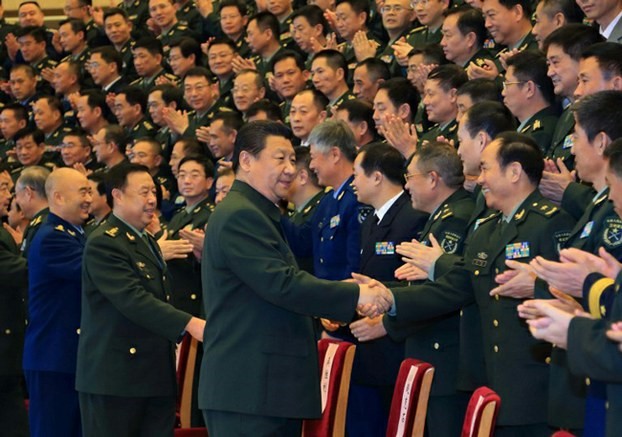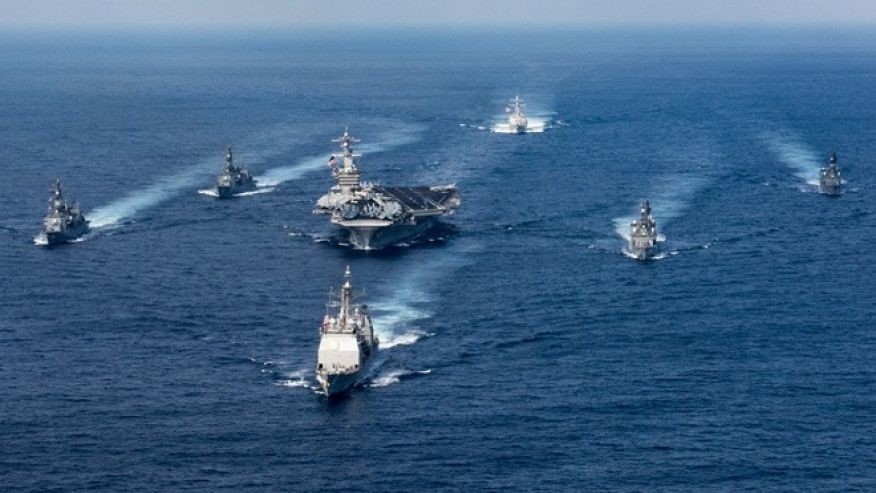Dragon In the South China Sea: Analysis of PLAN Expansion and Capabilities

August 6, 2017
In recent years, the cold waters in the South China Sea have become the hottest spot for a potential political or military clash. With President Trump sending mixed messages by halting freedom of navigation patrols, upholding the “One-China Policy”, and emphasizing North Korea as the most legitimate threat to the Far East, Washington and America’s allies are concerned over China’s continuation to militarize the naval region. Since China shows no intention of relinquishing control from their acclaimed “nine-dash line,”1 the following inquiry is valid: is China’s positioning in the South China Sea threatening to American interests and what should Trump’s position be towards the regional waters? This question can be answered through an in-depth analysis of the People’s Liberation Army Navy (PLAN) and their ambitious plan for expansion and modernization.

There are several quintessential components as to why the People’s Republic of China (PRC) wishes to control close to ninety percent of the South China Sea. As a trade nation, the Chinese economy relies on the ability of cargo and commercial ships to move safely and quickly to and from Chinese ports and important trade nodes.2 These trade nodes, such as the Straits of Malacca, are significantly farther than the current capabilities of the PLAN as they currently do not have an effective blue water fleet. This means that should hostilities breakout, the Chinese military cannot adequately defend their trade economy. Securing this trade route is imperative to the PRC because close to 80% of China’s oil imports pass through the strait.3 Furthermore, the dramatic increase of the Chinese economy has brought an upsurge of reliance on energy sources. The discovery of natural gas and oil in the region by the US Geological Survey in the 1990s has sparked interest from the Chinese government.4 This has led to the construction of artificial islands on the Spratly reefs and an increase of hostility with other claimants like the Philippines, Vietnam, Malaysia, and Brunei. These two factors have persuaded the PRC to invest in naval military spending by assuring politicians that the economy relies on the projection of Chinese naval power. Building off the surplus generated by a growing economy, the PLAN intends to use their new naval capabilities to achieve several goals: strengthen the ability to forcefully claim Taiwan, defend the vulnerable Chinese coastline, preserve and enforce China’s claims over islands and reefs in the South China Sea, assert their economic rights to expand offshore and acquire maritime resources, and secure important trade routes, trade nodes, and sea lanes.

To accomplish their ambitions, the PLAN has initiated three phases to expand their naval power. Phase one, which has already been completed to a great extent, includes the construction of off-coast capability to respond to threats. According to Naval Command Academy Professor Liu Yijian, “[Phase 1] includes the development of large-scale operation platforms (zuozhan pingtai) and intermediate- and long-range precision-guided munitions”.5 The Chinese have invested considerable time into the research and development of new naval ships, with keen interest in a domestic aircraft carrier. The modernization and the development of domestic aircraft carriers shows that the PLAN are interested in a platform that is capable of projecting power over large distances.

Displacing at about 60,000 tons, the Liaoning is one the largest carriers owned by the Pacific Asian nations. While underwhelming with an inefficient power supply and lack of an aircraft catapult,6 the launch of the larger and more modern Type 001A in late April of 2017 raises more than a few eyebrows. Its ability to carry 25-30 fighters and 12 helicopters gives the PLAN the ability to conduct operational missions that range from search and rescue, to anti-surface warfare, or to off-shore air superiority. With more aircraft carriers on the way, including a nuclear powered carrier that is expected to be launched in late of 2020, China’s new warships demonstrate their assent to superpower status.7 The development of the Dong Feng missiles such as the DF-21 and the DF-26 now possesses a realistic threat to US naval forces.8 The growing number of DF-21D medium-range ballistic missiles have an impressive speed of Mach 10 with a range exceeding 820 nautical miles. These weapons could very well heavily damage or possibly destroy an American Nimitz-class carrier, once thought impossible without the improvement in ballistic missile guidance technology.9

Phase two outlines the importance of China’s ability to control the sea regions that hold Chinese investments, “…the PLAN should evolve into a force that has a core of large- and medium-sized operational platforms capable of effectively controlling the offshore sea area (jinhai haiyu) within the first island chain”.5 To further this plan, the PLAN has constructed artificial islands on reefs around the Spratly Islands and built military installations on them such as airstrips, anti-aircraft weapons, and radars. Steven Stashwick expands in his article discussing militarization on the Spratly Islands, “Western analysts and military officials, including the head of the U.S. Pacific Command, generally consider China’s South China Sea bases, which include runways, hardened hangars for military aircraft, advanced long-range sensor systems, and some short-range weapons systems, as evidence that China has militarized the Spratly Islands.”10 While he discusses the difficulty of whether the introducing of such weapon systems are considered offensive capability by the PRC, clearly, these assets further solidifies China’s control over the sea region.
The third phase is the vision of the PLAN to become a blue-water navy, “…[PLAN] will have a core of large-scale operation platforms, and possess not only the ability to operate throughout the Northwest Pacific, but also the ability to attain command of the sea (zhihaiquan) in this area”.5 To achieve this, the PLAN has modernized its destroyer and frigate fleet to complement their two carriers. With more than eighteen Luyang-II and Luyang-III class destroyers phasing out the older Luda class, the PLAN is developing their capability to project their power safely on the high seas. With new active-phased-array radars, these new destroyers can effectively present a capable air defense network. Supplemented by more than twenty modern Jiangkai frigates, China’s naval industrial production is starting to show off.11

While, the PRC’s military expansion is quite impressive and modern, they still fall short in the face the of the United States Navy (USN). While the Liaoning and the Type 001A are the largest and modern carriers in the Far East owned by an Asian nation, the USN have eleven Nimitz-class carriers, each with a displacement of about 100,000 tons and two nuclear reactors. With the ability to hold more than 60 aircraft that includes advanced air superiority, electronic warfare, early warning, and logistical support aircraft, the air power that these carriers can represent on the high seas is overwhelming.12 While the China’s arsenal of ballistic missiles are indeed scary, the USN has ways of circumventing or avoiding them entirely. Firstly, the destructive power of the DF-21 and the DF-26 can be bypassed by simply having American carriers conduct operations outside of their range. Moreover, a carrier must be detected and remain in contact either through signal intelligence or radar. This would be increasingly difficult to do due to the USN’s ability to obtain air superiority to deny the PLAN’s access to early warning detection and air surveillance radar. Although the PLAN now has a high frequency radar on Cuarteron Reef, high capacity runways on several Spratly Islands, and harden aircraft shelters, these constructions lack any real offensive capabilities to intimidate a carrier battle group. These phases give analysts a good clue into the future of the PLAN. The PLAN views itself as a navy that should control and command the high seas, much like the United States. However, the current strength of the USN is overwhelming, and with possible conflict on the horizon, it would make sense for the PLAN to not challenge US carrier groups on the high seas, but instead, adopt an area-denial, anti-access strategy that is focused on containment and local security.13 Given this information, it is not hard to predict that the Chinese navy’s operational range will likely expand in the next years.

So, is China’s positioning in the South China Sea threatening to American interests? The answer: not yet. While the acquisition of new modern warships, missiles, and militarized artificial islands is a cause for concern, they have yet to match the technologically superior American warships such as the Arleigh Burke class destroyers, the Nimitz nuclear-powered aircraft carrier, or the Ohio-class submarines. Their focus on hunkering down the South China Sea has limited their ability to project power on a level that is even remotely equivalent to the United States Navy. Also, there is little evidence that they retain the ability to conduct joint military coordination not only between the PLAN and their air force, but also between the higher and lower chains of command. While China’s military prowess remains dormant, it is rapidly expanding and evolving. Trump and policy makers in Washington should remain vigilant and consistently assess China’s intentions and aggressions in the region, lest the South China Sea becomes either swallowed by an economic rival, or the site of a regional conflict.
Sources
[1] http://thediplomat.com/2016/06/what-does-the-nine-dash-line-actually-mean/
[2] http://www.e-ir.info/2016/02/26/securing-the-energy-supply-chinas-malacca-dilemma/
[3] ibid
[4]https://www.forbes.com/forbes/welcome/?toURL=https://www.forbes.com/sites/timdaiss/2016/05/22/why-the-south-china-sea-has-more-oil-than-you-think/&refURL=https://www.google.com/&referrer=https://www.google.com/
[5] Erickson, Andrew S., and Department of Defense. The Chinese Navy: Expanding Capabilities, Evolving Roles – Senkakus, Taiwan, Diaoyu, Paracel, Spratly Islands… N.p.: n.p., 2014. Print.
[6] http://chinapower.csis.org/aircraft-carrier/
[7] http://www.popsci.com/china-new-aircraft-carrier-type-001a
[8] http://www.globalsecurity.org/wmd/world/china/df-26.htm
[9] http://www.globalsecurity.org/wmd/world/china/df-21d.htm
[11] Report by Dean Cheng, Senior Research Fellow, Asian Studies Center: China’s Pivot to the Sea : The Modernizing PLA Navy
[12] http://www.navy.mil/navydata/fact_display.asp?cid=4200&tid=200&ct=4
[13] http://www.realcleardefense.com/articles/2016/09/13/a2ad_-_anti-accessarea_denial_110052.html
Categories
Jonathan Alegria View All
Sophomore at Fordham University studying political science and international affairs with a focus on American foreign policy, military science, and regional relations.
